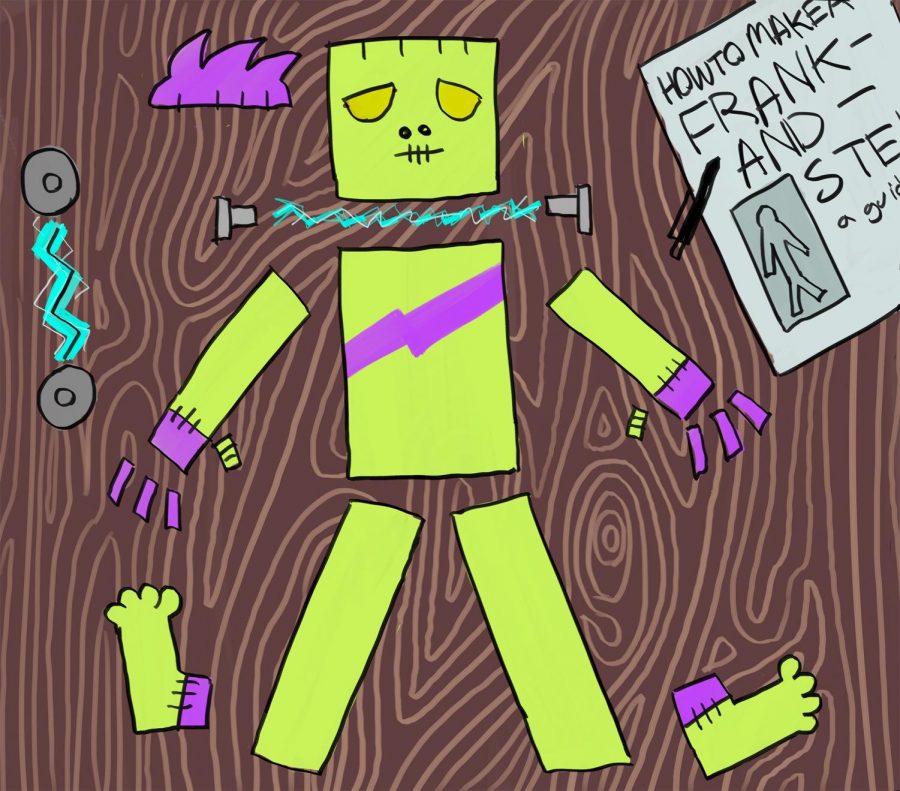SATIRE: Frankenstein-esque monsters at WSU
Body parts are stitched, glued and duct-taped together to form beast
NATALIE BLAKE | DAILY EVERGREEN ILLUSTRATION
The WSU Biological Science Department has received a grant from a donor named B. Karloff. The conditions of the grant include training students in the art of reanimation which is a medical science, says Nick Romancer.
October 31, 2019
A flash of lightning, a flip of a switch, a hum and a buzz of electricity and suddenly, the stitched-together corpse on the table springs to life with a guttural moan. It reaches for terrified onlookers with stiff fingers, as the cackling mad scientist in the corner screeches, “It’s ALIIIIIIVVVEEEEEE!”
A scene from the latest remake of Frankenstein or one of the WSU Biological Science Department’s latest experiments in abnormal biology? You’d be surprised to learn that, as of the 2019 fall semester, a sizable grant was donated (by a source who wished to be identified only as B. Karloff) to the WSU biology program, on one condition: that the biology department immediately begin training select students in the little-known art of reanimation.
“It’s one of the lesser-known facets of the various medical sciences,” said Nick Romancer, a WSU professor of postmortem reanimation, with a master’s degree in Playing God. “People tend to gloss over reanimation whenever they’re talking about the different ways you can apply biology to real life. It’s like, just because we’re disgraced scientists who corrupt and abuse the forces of nature in strange and twisted ways, our field of study suddenly doesn’t matter.”
However, human reanimation as an art is finely detailed, with numerous years of study and practice needed to achieve perfection. Mary Shelley, a WSU professor of Extremely F-cked Up Science Magic, explained the process to me.
“As a general rule, we collect recently deceased human body parts from graveya– uh, from ethical and legal sources as per Washington state law,” Shelley said. “Those body parts are then stitched, glued and sometimes duct-taped together in the form of a person-three hands, two legs, an undisclosed number of feet, the works.”
The reanimator then applies a significant amount of electricity to the corpse at specific intervals, which acts as a catalyst for the reanimation process.
“Yeah, we used to use lightning back in the day, I guess,” Shelley said, drinking from a large bottle filled with a mysterious red liquid.
(When asked about what she was drinking, Shelley paused for an uncomfortably long period of time, then said “Tea,” and abruptly changed the subject.)
“But lightning’s such a pain in the ass, you know?” she said. “I mean, I don’t want to wait for a thunderstorm every time I wanna get some Franks cooking for my grad student class. So I use the battery from my 1998 Honda Civic and some jumper cables. If you give it a good zap, it works just as good as the real thing.”
Upon reanimation, the corpse has the tendency to be homicidal and confused, often lashing out at its creator or those around it for bringing it back to life. Some WSU professors have taken to leaving certain appendages off their creations, in order to minimize damage to themselves and their students.
“It’s pretty funny to see a scientific abomination that spits in the face of God Himself try to strangle you with no arms,” Romancer said. “Kinda brings a little light to your day.”
With the new biology grant, which totals exactly $666 million, more mad science and reanimation classes will be offered through the Life (But Is It, Though?) Sciences department, giving a whole new generation of WSU students the opportunity to flip the oversized metal switch and bring a cobbled-together collection of body parts to something resembling life.
Classes such as “BIO 203: Advanced Grave Robbing,” “COM 103: Maniacal Post-Experiment Laughter,” “MUSIC 666: Sinister Pipe Organ Riffs” and numerous others will help hundreds of students become outcast mad scientists, exiled to a crumbling castle with only their hunchback sidekick (generally a business major) for company.
“I think this is a great opportunity for anyone who really wants to make their dreams, or nightmares, come true,” Romancer said. “Reanimation is really the wave of the future. Everyone wants a drooling, eight-foot-tall, undead servant. I mean, McDonald’s is already subcontracting with Stanford to replace most of their workforce with Frankenstein Model 99s to increase productivity and save money. It’s a fantastic business strategy, honestly.”
“I’m just happy we’re finally getting our recognition and funding as legitimate members of the WSU biology department,” Shelley said. “Maybe now I can set up an actual lab, not just a workspace at the top of the clock tower, where I have to look down on the whole campus and laugh maniacally.”
The biology department will benefit from this generous grant, and so will the scientific community as a whole. In fact, the WSU Environmental Science Department is already in cooperation with some of the reanimated corpses, who, because of their brute undead strength, are ideal for waste compacting. In other words, they do the mash. They do the monster mash.










Elizabeth Schaeffer • Oct 31, 2019 at 11:56 am
Brilliant article Jacob. Not sure if my last text came through because I got dropped at the last moment. I think it is wonderful; currently topical, to eloquently gaffaw at the concept of resurrecting life. Humans just can’t seem to let go. Only knowledge of a real afterlife will end the desperate and astronomically expensive quest.